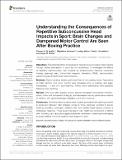Files in this item
Understanding the consequences of repetitive subconcussive head impacts in sport : brain changes and dampened motor control are seen after boxing practice
Item metadata
| dc.contributor.author | Di Virgilio, Thomas G. | |
| dc.contributor.author | Ietswaart, Magdalena | |
| dc.contributor.author | Wilson, Lindsay | |
| dc.contributor.author | Donaldson, David I. | |
| dc.contributor.author | Hunter, Angus M. | |
| dc.date.accessioned | 2020-01-29T14:30:01Z | |
| dc.date.available | 2020-01-29T14:30:01Z | |
| dc.date.issued | 2019-09-10 | |
| dc.identifier | 266041446 | |
| dc.identifier | 4853f65d-e5f3-4559-a3aa-42102f65268b | |
| dc.identifier | 85072881156 | |
| dc.identifier.citation | Di Virgilio , T G , Ietswaart , M , Wilson , L , Donaldson , D I & Hunter , A M 2019 , ' Understanding the consequences of repetitive subconcussive head impacts in sport : brain changes and dampened motor control are seen after boxing practice ' , Frontiers in Human Neuroscience , vol. 13 , 294 . https://doi.org/10.3389/fnhum.2019.00294 | en |
| dc.identifier.issn | 1662-5161 | |
| dc.identifier.other | ORCID: /0000-0002-8036-3455/work/68281966 | |
| dc.identifier.uri | https://hdl.handle.net/10023/19379 | |
| dc.description | LW was supported by FP7 grant number 602150-2 (CENTER-TBI) | en |
| dc.description.abstract | Objectives: The potential effects of exposure to repetitive subconcussive head impacts through routine participation in sport are not understood. To investigate the effects of repetitive subconcussive head impacts we studied boxers following customary training (sparring) using transcranial magnetic stimulation (TMS), decomposition electromyographic (EMG) and tests of memory. Methods: Twenty amateur boxers performed three 3-min sparring bouts. Parameters of brain function and motor control were assessed prior to sparring and again immediately, 1 h and 24 h post-sparring. Twenty control participants were assessed following mock-sparring. Results: One hour after sparring boxers showed increased corticomotor inhibition, altered motor unit recruitment strategies, and decreased memory performance relative to controls, with values returning to baseline by the 24 h follow up. Conclusion: Repetitive subconcussive head impacts associated with sparring resulted in acute and transient brain changes similar to those previously reported in soccer heading, providing convergent evidence that sport-related head impacts produce a GABAergic response. These acute changes in brain health are reminiscent of effects seen following brain injury, and suggest a potential mechanism underlying the damaging long-term effects of routine repetitive head impacts in sport. | |
| dc.format.extent | 2975957 | |
| dc.language.iso | eng | |
| dc.relation.ispartof | Frontiers in Human Neuroscience | en |
| dc.subject | Boxing | en |
| dc.subject | Motor unit behavior | en |
| dc.subject | Subconcussive head impacts | en |
| dc.subject | TBI | en |
| dc.subject | Transcranial magnetic stimulation | en |
| dc.subject | RC0321 Neuroscience. Biological psychiatry. Neuropsychiatry | en |
| dc.subject | Psychiatry and Mental health | en |
| dc.subject | Behavioral Neuroscience | en |
| dc.subject | Biological Psychiatry | en |
| dc.subject | Neurology | en |
| dc.subject | Neuropsychology and Physiological Psychology | en |
| dc.subject | NDAS | en |
| dc.subject | SDG 3 - Good Health and Well-being | en |
| dc.subject.lcc | RC0321 | en |
| dc.title | Understanding the consequences of repetitive subconcussive head impacts in sport : brain changes and dampened motor control are seen after boxing practice | en |
| dc.type | Journal article | en |
| dc.contributor.institution | University of St Andrews. Health Psychology | en |
| dc.contributor.institution | University of St Andrews. School of Psychology and Neuroscience | en |
| dc.identifier.doi | https://doi.org/10.3389/fnhum.2019.00294 | |
| dc.description.status | Peer reviewed | en |
This item appears in the following Collection(s)
Items in the St Andrews Research Repository are protected by copyright, with all rights reserved, unless otherwise indicated.

